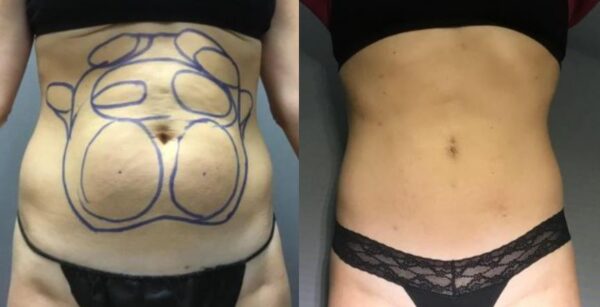
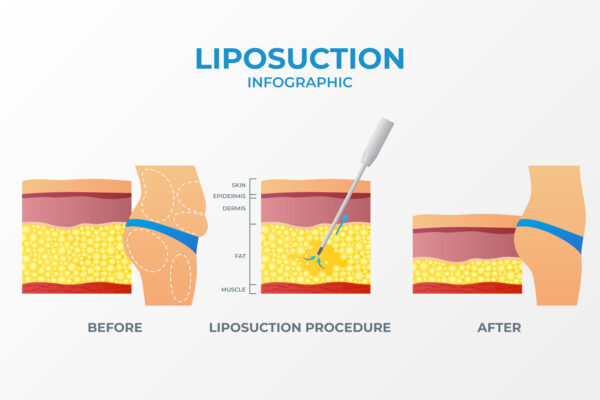
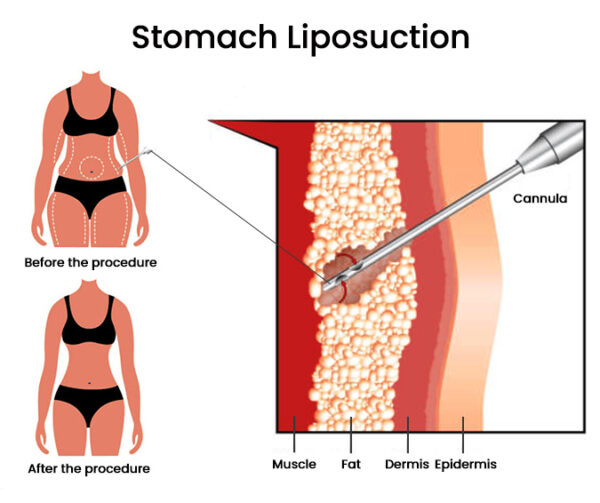
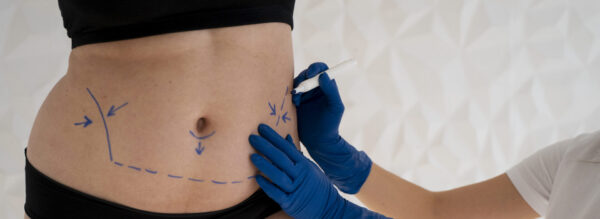

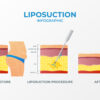
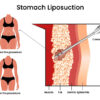

Free
Embark on a transformative journey with our exceptional range of medical treatments. As a leading medical tour operator, we offer a comprehensive selection of world-class treatments and procedures to address your unique healthcare needs. From advanced surgeries to cutting-edge therapies, our team of experienced professionals is dedicated to providing top-notch care and ensuring your comfort and satisfaction. Discover a new level of healthcare excellence with our tailored treatment options. Book now to start your journey towards a healthier and happier you.
Traditional liposuction, also known as suction-assisted liposuction (SAL), is a surgical procedure that aims to remove excess fat from specific areas of the body to improve body contour and shape. Here is an explanation of the procedure based on the information from the search results:
Anesthesia: Before the procedure, anesthesia is administered to ensure patient comfort. The options for anesthesia include general anesthesia, intravenous sedation, or local anesthesia, depending on the patient’s needs and the extent of the procedure 1.
Incisions: Small, inconspicuous incisions are made in the targeted areas of the body. These incisions allow the insertion of a hollow stainless steel tube called a cannula 1. The size and number of incisions may vary depending on the specific technique used and the amount of fat being removed.
Tumescent Solution: Prior to the fat removal process, a tumescent solution is infused into the targeted area. This solution typically consists of a saline solution mixed with a local anesthetic (lidocaine) and a vessel-constrictor (epinephrine). The tumescent solution helps to numb the area, minimize bleeding, and facilitate fat removal 2.
Fat Removal: Once the tumescent solution has taken effect, the surgeon inserts the cannula through the incisions and uses a back-and-forth motion to break up and suction out the excess fat cells. The cannula is connected to a vacuum or suction device that removes the fat from the body 1.
Techniques and Advances: Traditional liposuction techniques have evolved over time, and there have been advancements to improve patient safety and outcomes. For example, laser-assisted liposuction (LAL) uses laser energy to liquefy fat cells before removal, while power-assisted liposuction (PAL) uses a reciprocating motion of the cannula to facilitate fat removal. These techniques aim to enhance the efficiency and effectiveness of the procedure 3.
Areas of Treatment: Traditional liposuction can be performed on various areas of the body, including the abdomen, hips, thighs, buttocks, arms, neck, and face 1. It is important to note that the specific areas that can be treated may vary depending on individual patient needs and the surgeon’s expertise.
Liposuction is a highly individualized procedure, and the suitability for traditional liposuction can vary depending on several factors. Here are some points to consider based on the information from the search results:
Ideal Candidates: Ideal candidates for liposuction, including traditional liposuction, are typically adults within 30% of their ideal weight, have firm and elastic skin, and good muscle tone. They should be in good overall health without any life-threatening illnesses or medical conditions that can impair healing. Non-smokers and individuals with a positive outlook and specific goals for body contouring are also considered suitable candidates.
Excess Fat Deposits: Liposuction, including traditional liposuction, is suitable for individuals who are bothered by excess fat deposits that do not respond to diet or exercise. It is important to note that liposuction is not a weight-loss method but rather a procedure to remove localized areas of excess fat and improve body contour.
Skin Elasticity: The elasticity of the skin is an important factor in determining the suitability for liposuction. Patients with firm and elastic skin tend to have better results as the skin can reshape well after fat removal. However, individuals with soft and thin skin due to factors such as stretch marks, weight loss, or natural aging may not experience the same level of reshaping and may require additional surgeries to remove and tighten excess skin.
Health Considerations: The overall health of the individual is an important consideration for liposuction. Candidates should be in good health and free from any medical conditions that can increase the risk of complications or impair the healing process.
Consultation with a Surgeon: The best way to determine if traditional liposuction is suitable for an individual is through a consultation with a qualified plastic surgeon. The surgeon will assess the patient’s specific needs, evaluate their health status, and discuss the potential risks and benefits of the procedure.
While liposuction, including traditional liposuction, can be beneficial for many individuals, there are certain cases where it may not be suitable. Here are some factors to consider based on the information from the search results:
Obesity: Liposuction is not a weight loss solution for individuals who are significantly overweight or obese. It is important to note that liposuction is intended to remove localized areas of excess fat and improve body contour, not for overall weight reduction. For individuals who are obese, other weight loss methods, such as diet and exercise, may be more appropriate.
Poor General Health: Liposuction is a surgical procedure, and individuals with certain medical conditions may not be suitable candidates. Conditions such as uncontrolled diabetes, heart disease, blood clotting disorders, compromised immune systems, or other serious health conditions may increase the risk of complications during or after the surgery.
Unrealistic Expectations: Liposuction can provide significant improvements in body contour, but it is important for individuals to have realistic expectations. It is not a magical solution for achieving the “perfect” body. Patients should have a clear understanding of the limitations and potential outcomes of the procedure.
Pregnancy or Breastfeeding: Liposuction is not recommended for individuals who are pregnant or breastfeeding. It is generally advisable to wait until after pregnancy and breastfeeding to undergo liposuction to ensure the safety and well-being of both the mother and the baby.
Poor Skin Elasticity: Individuals with poor skin elasticity may not achieve the desired results from liposuction alone. Liposuction removes fat, but it does not address sagging or loose skin. In such cases, additional procedures like a tummy tuck or body lift may be necessary to achieve the desired outcome.
Psychological Considerations: Liposuction is not suitable for individuals with unrealistic body image expectations or those seeking the procedure as a solution to underlying psychological issues. It is important to have a positive body image and realistic expectations before undergoing any cosmetic procedure.
Based on the information from the search results, there are certain cases where liposuction, including traditional liposuction, may not be suitable. Here are some factors to consider:
Obesity: Liposuction is not a weight loss solution for individuals who are significantly overweight or obese. It is important to note that liposuction is intended to remove localized areas of excess fat and improve body contour, not for overall weight reduction. For individuals who are obese, other weight loss methods, such as diet and exercise, may be more appropriate.
Poor General Health: Liposuction is a surgical procedure, and individuals with certain medical conditions may not be suitable candidates. Conditions such as uncontrolled diabetes, heart disease, blood clotting disorders, compromised immune systems, or other serious health conditions may increase the risk of complications during or after the surgery.
Poor Skin Elasticity: Individuals with poor skin elasticity may not achieve the desired results from liposuction alone. Liposuction removes fat, but it does not address sagging or loose skin. In such cases, additional procedures like a tummy tuck or body lift may be necessary to achieve the desired outcome.
Unrealistic Expectations: Liposuction can provide significant improvements in body contour, but it is important for individuals to have realistic expectations. It is not a magical solution for achieving the “perfect” body. Patients should have a clear understanding of the limitations and potential outcomes of the procedure.
Pregnancy or Breastfeeding: Liposuction is not recommended for individuals who are pregnant or breastfeeding. It is generally advisable to wait until after pregnancy and breastfeeding to undergo liposuction to ensure the safety and well-being of both the mother and the baby.
Psychological Considerations: Liposuction is not suitable for individuals with unrealistic body image expectations or those seeking the procedure as a solution to underlying psychological issues. It is important to have a positive body image and realistic expectations before undergoing any cosmetic procedure.
Liposuction, including traditional liposuction, is a surgical procedure that carries certain risks and potential complications. Here are some points to consider based on the information from the search results:
Anesthesia Risks: Liposuction requires anesthesia, and there are inherent risks associated with anesthesia administration. These risks can include allergic reactions, respiratory problems, and adverse reactions to medications. An anesthesiologist or qualified healthcare professional will closely monitor the patient during the procedure to minimize these risks.
Bruising and Swelling: Bruising and swelling are common after liposuction and can vary in severity depending on the extent of the procedure. These side effects typically subside over time but can cause discomfort and temporary changes in the appearance of the treated area.
Infection: Infection is a potential risk after any surgical procedure, including liposuction. To minimize the risk of infection, surgeons typically prescribe antibiotics and provide instructions for proper wound care. It’s important for patients to follow these instructions diligently.
Irregular Contours or Asymmetries: Liposuction aims to improve body contour and shape, but there is a risk of irregular contours or asymmetries in the treated area. Factors such as uneven fat removal, uneven healing, or individual variations in tissue response can contribute to these outcomes. Revision surgery may be necessary to address these issues.
Fluid Accumulation: Fluid accumulation, known as seroma, can occur after liposuction. Surgeons may place drains or use compression garments to minimize the risk of seroma formation. In some cases, aspiration or drainage of the fluid may be necessary.
Deep Vein Thrombosis and Pulmonary Complications: Liposuction, like any surgery, carries a risk of deep vein thrombosis (DVT) and pulmonary complications such as blood clots. Surgeons take precautions to minimize these risks, including the use of compression stockings, early ambulation, and the administration of blood thinners when necessary.
Skin Sensation Changes: Temporary changes in skin sensation, such as numbness or altered sensitivity, can occur after liposuction. These changes typically resolve over time, but in some cases, they may persist.
Preoperative care refers to the physical and psychosocial care provided to patients before undergoing surgery. The goal of preoperative care is to ensure the patient’s safety and optimize their outcomes after the surgical procedure. Here are some key points about preoperative care based on the information from the search results:
Assessment and Evaluation: Preoperative care begins with a thorough assessment and evaluation of the patient’s medical history, physical condition, and specific needs. This includes obtaining a detailed medical history, conducting a physical examination, and performing any necessary tests or evaluations to assess the patient’s fitness for surgery 1.
Patient Education: Patient education is an essential component of preoperative care. During this phase, healthcare professionals provide information to the patient about the surgical procedure, potential risks and benefits, expected outcomes, and postoperative care instructions. This helps the patient understand what to expect and actively participate in their own care 2.
Preoperative Testing: Depending on the type of surgery and the patient’s medical condition, various preoperative tests and assessments may be conducted. These tests can include blood work, imaging studies, electrocardiograms (ECGs), and consultations with other specialists to ensure the patient is in the best possible condition for surgery 2.
Medication and Preparation: Preoperative care involves reviewing the patient’s current medications and making any necessary adjustments or modifications. This may include discontinuing certain medications that can interfere with the surgery or adjusting the dosage of others. Additionally, patients may be instructed to fast for a specific period before surgery to minimize the risk of complications related to anesthesia 3.
Addressing Anxiety and Comfort: Preoperative care aims to address the patient’s anxiety and ensure their comfort before surgery. This can involve providing emotional support, answering questions, and offering relaxation techniques or medications to help alleviate anxiety.
Consent and Documentation: Obtaining informed consent from the patient is an important part of preoperative care. The healthcare team ensures that the patient understands the risks, benefits, and alternatives of the procedure and signs the necessary consent forms. Documentation of the preoperative assessment, education, and consent is essential for accurate and comprehensive patient care 3.
Postoperative care refers to the care provided to patients after they have undergone surgery. The goal of postoperative care is to promote healing, manage pain, prevent complications, and support the patient’s recovery. Here are some key points about postoperative care based on the information from the search results:
Monitoring Vital Signs: After surgery, healthcare professionals closely monitor the patient’s vital signs, including blood pressure, heart rate, respiratory rate, and temperature. This helps ensure the patient’s stability and allows for early detection of any potential complications.
Pain Management: Effective pain management is an important aspect of postoperative care. Healthcare professionals may prescribe pain medications or use other techniques such as epidurals, patient-controlled analgesia (PCA), or non-pharmacological methods to help control pain and discomfort.
Wound Care: Proper wound care is crucial for preventing infection and promoting healing. This may involve regularly cleaning and dressing the surgical incision site, as well as monitoring for any signs of infection, such as redness, swelling, or drainage.
Mobility and Ambulation: Early mobilization and ambulation are encouraged as soon as the patient’s condition allows. Moving and walking help prevent complications such as blood clots and promote circulation and healing.
Nutrition and Hydration: Adequate nutrition and hydration are essential for the healing process. Healthcare professionals may provide guidance on a balanced diet and encourage the patient to drink fluids to maintain hydration.
Respiratory Care: Depending on the type of surgery, patients may receive respiratory care to prevent complications such as pneumonia or atelectasis. This may involve deep breathing exercises, the use of incentive spirometry, or the administration of respiratory treatments.
Preventing Complications: Postoperative care includes measures to prevent complications such as infections, blood clots, and pressure ulcers. This may involve administering prophylactic medications, using compression stockings, assisting with frequent position changes, and providing appropriate skin care.
Patient Education: Patient education continues during the postoperative period. Healthcare professionals provide instructions on postoperative care, including medication management, wound care, activity restrictions, and signs of potential complications. This empowers the patient to actively participate in their recovery process.
Only logged in customers who have purchased this product may leave a review.
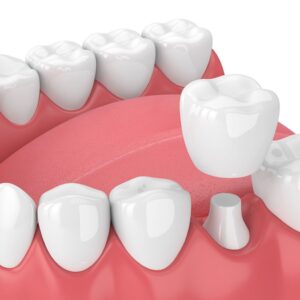

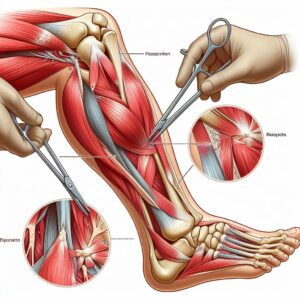



Tumescent liposuction is a popular and minimally invasive technique for removing excess fat from the body. It involves injecting a solution composed of saline (saltwater), lidocaine (a local anesthetic), and epinephrine (a blood vessel constrictor) into the targeted fat deposits. This solution helps to numb the area, shrink blood vessels to minimize bleeding, and make the fat easier to remove.
The procedure typically begins with the administration of local anesthesia to the targeted area, which helps to minimize discomfort during the surgery. Once the area is numb, small incisions are made in the skin, and the tumescent solution is injected into the fatty tissue.
The next step involves the insertion of a thin tube called a cannula through the incisions. The cannula is used to break up and suction out the emulsified fat deposits. The surgeon moves the cannula back and forth to dislodge the fat cells, which are then suctioned out of the body through a vacuum device attached to the cannula.
Tumescent liposuction is known for its precision and ability to sculpt the body in targeted areas. It is commonly used on areas such as the abdomen, hips, thighs, buttocks, arms, and chin. The tumescent technique results in less blood loss, reduced bruising and swelling, and typically allows for a faster recovery compared to traditional liposuction methods.
After the procedure, patients may be required to wear compression garments to support the treated areas and help minimize swelling. Recovery time varies depending on the extent of the liposuction and the individual’s healing process.
Tumescent liposuction is generally considered suitable for individuals who are at or near their ideal body weight but have stubborn areas of localized fat that are resistant to diet and exercise. It is important to note that liposuction is not a weight loss solution, but rather a body contouring procedure to sculpt and reshape specific areas of the body.
Candidates for tumescent liposuction should be in good overall health and have realistic expectations about the outcomes of the procedure. This technique can be used to treat various areas of the body where excess fat accumulates, including:
1. Abdomen
2. Hips and thighs
3. Buttocks
4. Flanks (love handles)
5. Arms
6. Back
7. Chin and neck
Tumescent liposuction is suitable for both men and women who are bothered by localized pockets of fat that do not respond to diet and exercise. It is important for candidates to have good skin elasticity to ensure optimal results, as liposuction removes fat but does not tighten loose or sagging skin.
It is recommended that candidates for tumescent liposuction be non-smokers, as smoking can increase the risk of complications during and after the procedure. Additionally, patients should be committed to maintaining a healthy lifestyle after liposuction to prevent future weight gain and maintain their results.
Tumescent liposuction may not be suitable for individuals who fall into certain categories. Here are some factors to consider:
Obesity and Significant Weight Loss: Tumescent liposuction is not intended as a treatment for obesity or a method for significant weight loss. Candidates for any form of liposuction, including tumescent liposuction, are generally recommended to be within 30 percent of their ideal body weight. It’s important to note that liposuction is not a weight-loss procedure, and it should not be used as such.
Medical Conditions and Skin Elasticity: Individuals with certain serious underlying medical conditions or those with poor skin elasticity may not be ideal candidates for tumescent liposuction. Good skin elasticity and muscle tone are factors that can contribute to better results from the procedure.
Cellulite Treatment: Tumescent liposuction is not a treatment for cellulite. It is important to manage expectations regarding the outcomes of the procedure, as it is primarily focused on removing localized fat deposits that are resistant to conventional methods of diet and exercise.
Smoking: Ideally, candidates for tumescent liposuction should be nonsmokers, as smoking can impair the healing process post-surgery.
Tumescent liposuction offers several advantages over traditional liposuction techniques. Here are some of the benefits:
Safety: Tumescent liposuction is considered one of the safest options for cosmetic fat removal. The use of local anesthesia instead of general anesthesia reduces the risks associated with anesthesia. This can lead to a smoother recovery process and minimize the potential for complications.
Reduced Bleeding: The tumescent solution used in this technique causes the blood vessels in the treatment area to shrink. As a result, patients experience less bleeding during the procedure compared to other forms of fat removal. This can contribute to a safer and more controlled surgical process.
Faster Recovery: Tumescent liposuction is associated with a shorter recovery time compared to traditional liposuction. The reduced trauma and bleeding during the procedure can lead to a quicker healing process. Most patients can resume their normal activities within a few days, although it’s important to follow the post-operative instructions provided by the surgeon.
Improved Contouring: The tumescent technique allows the surgeon to have better control and precision during the fat removal process. The solution swells the fat cells, making them easier to break down and suction out. This can result in more accurate contouring and a smoother outcome.
Local Anesthesia: Tumescent liposuction only requires local anesthesia to numb the treatment area, eliminating the need for general anesthesia. This reduces the risks associated with general anesthesia and can lead to a more comfortable experience for the patient.
Tumescent liposuction is generally considered a safe procedure with a low risk of complications. However, it’s important to be aware of potential risks and complications associated with any surgical procedure. Here are some considerations:
Infection: Although rare, there is a risk of infection following tumescent liposuction. It’s important to follow post-operative care instructions provided by your surgeon to minimize the risk of infection.
Bleeding and Hematoma: While the use of the tumescent solution helps minimize bleeding during the procedure, there is still a small risk of bleeding and hematoma formation (collection of blood under the skin). Your surgeon will take precautions to minimize these risks.
Contour Irregularities: In some cases, contour irregularities or unevenness may occur after tumescent liposuction. This can happen if the fat is not evenly removed or if there is uneven healing. Massaging the treated area during the recovery period can help improve the contour.
Fluid Imbalance: Although the tumescent solution helps minimize fluid shifts, there is still a possibility of fluid imbalance. This can lead to swelling, fluid accumulation, or changes in blood pressure. Following post-operative instructions, including wearing compression garments, can help manage fluid balance.
Skin Sensation Changes: Temporary changes in skin sensation, such as numbness or tingling, may occur after tumescent liposuction. These changes usually resolve over time, but it’s important to discuss any concerns with your surgeon.
Allergic Reactions: While rare, allergic reactions to the medications used in the tumescent solution can occur. It’s important to inform your surgeon about any known allergies or sensitivities before the procedure.
Skin Irregularities: In some cases, the skin may appear uneven or have a rippled texture after tumescent liposuction. This can be more common in individuals with poor skin elasticity. Your surgeon can discuss the likelihood of this occurring based on your individual circumstances.
Preoperative care refers to the physical and psychosocial care provided to prepare a patient for surgery safely. It involves a series of steps and assessments to ensure the patient is in the best possible condition for the surgical procedure. Here are some key aspects of preoperative care:
Medical History and Physical Examination: A thorough medical history and physical examination are conducted to assess the patient’s overall health and identify any preexisting conditions or risk factors that may impact the surgery. This includes evaluating the patient’s medications, allergies, previous surgeries, and current health status.
Preoperative Testing: Depending on the patient’s medical history and the type of surgery planned, various preoperative tests may be ordered. These can include blood tests, imaging studies, electrocardiogram (ECG), and other specialized tests to evaluate the patient’s organ function and overall health.
Patient Education: Patient education is a crucial component of preoperative care. The patient is provided with information about the surgical procedure, including its purpose, potential risks and benefits, expected outcomes, and postoperative care instructions. This helps the patient understand what to expect and actively participate in their own care.
Preparation for Anesthesia: If general anesthesia is planned, the patient may need to fast for a certain period before the surgery to minimize the risk of aspiration. The anesthesiologist will evaluate the patient’s fitness for anesthesia and discuss the anesthesia plan, including potential risks and side effects.
Medication Management: The patient’s medications are reviewed, and adjustments may be made based on the surgical procedure and anesthesia requirements. This includes guidance on which medications to continue taking, which ones to temporarily stop, and any additional medications needed for the perioperative period.
Preoperative Instructions: The patient is given specific instructions regarding fasting, hygiene, medication administration, and any other preparations required before the surgery. This may include restrictions on eating or drinking, showering with a special antiseptic soap, and avoiding certain medications or supplements.
Emotional Support: Preoperative care also involves addressing the patient’s emotional well-being and providing support to alleviate anxiety or fears associated with the surgery. This can be done through effective communication, reassurance, and involving the patient’s support system.
Postoperative care refers to the care and monitoring provided to a patient after a surgical procedure. It aims to ensure a smooth recovery, manage pain, prevent complications, and promote healing. Here are some key aspects of postoperative care:
Recovery Area: After surgery, the patient is typically moved to a designated recovery area, such as a post-anesthesia care unit (PACU) or a dedicated surgical recovery room. Here, healthcare professionals monitor the patient’s vital signs, assess their level of consciousness, and manage any immediate postoperative concerns.
Pain Management: Effective pain management is essential for the patient’s comfort and recovery. This can include the administration of pain medications as prescribed by the surgeon or anesthesiologist. It may involve a combination of oral medications, intravenous analgesics, patient-controlled analgesia (PCA), or regional anesthesia techniques.
Monitoring and Observation: Postoperative care involves close monitoring of the patient’s vital signs, including blood pressure, heart rate, respiratory rate, and oxygen saturation. Healthcare professionals assess the patient’s level of consciousness, pain levels, and any signs of complications, such as bleeding, infection, or respiratory distress.
Wound Care: Proper wound care is crucial to prevent infection and promote healing. This may involve changing dressings, cleaning the incision site, and applying topical medications or ointments as instructed by the surgeon. It’s important to follow the specific wound care instructions provided by the healthcare team.
Mobility and Ambulation: Depending on the type of surgery and the patient’s condition, early mobilization and ambulation may be encouraged to prevent complications such as blood clots and promote circulation. Healthcare professionals provide guidance and assistance to gradually increase activity levels while ensuring patient safety.
Fluids and Nutrition: Adequate hydration and nutrition are important for postoperative recovery. Intravenous fluids may be administered initially, and the patient may gradually transition to a clear liquid diet and then to regular food as tolerated. It’s important to follow any dietary restrictions or guidelines provided by the healthcare team.
Education and Discharge Planning: Patient education plays a vital role in postoperative care. The patient and their caregivers are provided with instructions on managing pain, caring for the incision site, taking prescribed medications, and recognizing signs of complications. Discharge planning, including follow-up appointments and any necessary home care, is also discussed.
Emotional Support: Postoperative care includes addressing the patient’s emotional well-being and providing support during the recovery process. Healthcare professionals offer reassurance, answer questions, and provide guidance to help manage any emotional or psychological concerns.
There are no reviews yet.
Only logged in customers who have purchased this product may leave a review.
Choosing the right hospital and physician are important factors to consider that significantly influence a patient’s treatment. The preferred choice for many patients is choosing private care.
Choosing the right hospital and physician are important factors to consider that significantly influence a patient’s treatment.
Reviews
There are no reviews yet.